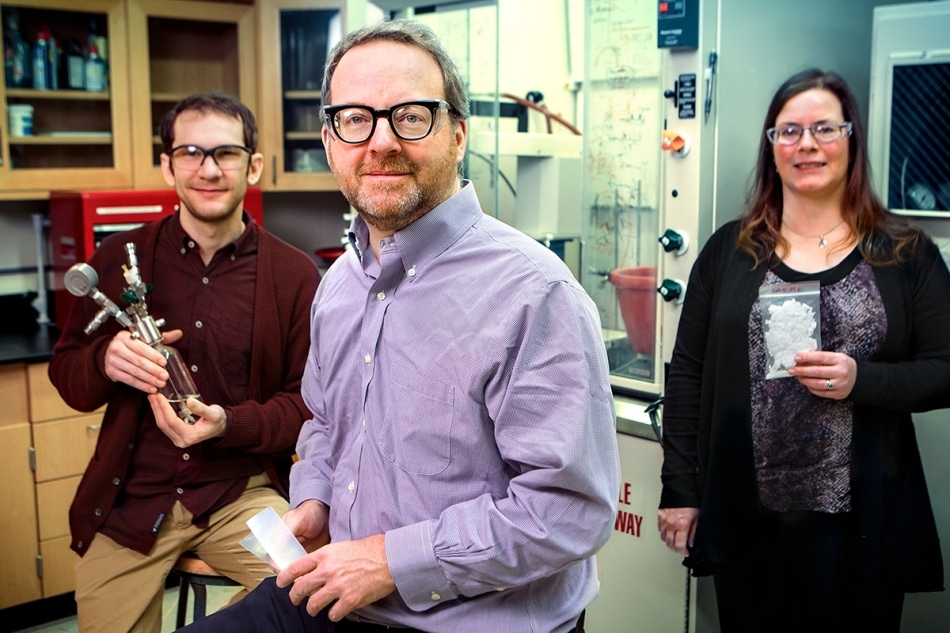Feb 24 2017
 Geoffrey Coates, center, in his lab with James Eagan, a postdoctoral researcher in Coates� group and researcher Anne LaPointe. (credit: Robert Barker/University Photography)
Geoffrey Coates, center, in his lab with James Eagan, a postdoctoral researcher in Coates� group and researcher Anne LaPointe. (credit: Robert Barker/University Photography)
During his talks relating to plastics and recycling, Professor of Chemistry and Chemical Biology, Geoffrey Coates from Tisch University, asks a question: What percentage of the 78 million tons of plastic used yearly for packaging – for instance, a take-out food container or a two-liter bottle – really gets recycled and reused in a similar manner?
According to the Ellen MacArthur Foundation, the answer is a mere 2 %. Unfortunately, about a third is leaked into the environment, approximately 14 % is used in energy recovery and/or incineration, and an enormous 40 % ends up in landfills.
One of the issues: Polypropylene (PP) and polyethylene (PE), which account for two-thirds of the total plastics globally, have varied chemical structures and hence cannot be repurposed together. Or, at least, an effective technology to meld these two materials into one has not been found in the 60 years these two materials have been available on the market.
However, a discovery made at Coates’ lab may change all that. He and his team have partnered with a group from the University of Minnesota to create a multiblock polymer. When it is incorporated in small measure to a mix of the two incompatible materials – PP and PE, creates a new and mechanically robust polymer.
Their research is illustrated in a paper, “Combining polyethylene and polypropylene: Enhanced performance with PE/iPP multiblock polymers,” published online on February 23 in Science.
James Eagan, a postdoctoral researcher in Coates’ group, is the paper’s lead author. Other partners included researcher Anne LaPointe and former visiting scientist Rocco DiGirolamo.
For years scientists have attempted to create a polymer that does what Coates, LaPointe and Eagan have accomplished. By incorporating a tiny amount of their tetrablock (four-block) polymer – with alternating polypropylene and polyethylene segments – the resulting material has strength better than diblock (two-block) polymers they tested.
In their experiments, two plastic strips were welded together using varied multi-block polymers as adhesives, and then mechanically separated from each other. While the welds formed using diblock polymers failed comparatively quickly, the weld formed from the team’s tetrablock additive held very well that the plastic strips broke instead.
People have done things like this before, but they’ll typically put 10 percent of a soft material, so you don’t get the nice plastic properties, you get something that’s not quite as good as the original material. What’s exciting about this, is we can go to as low as 1 percent of our additive, and you get a plastic alloy that really has super-great properties.
Geoffrey Coates, Professor, Tisch University
Eagan said this tetrablock polymer not only exhibits promise for enhancing recycling, but also could generate a whole new class of mechanically tough polymer blends.
“If you could make a milk jug with 30 percent less material because it’s mechanically better, think of the sustainability of that,” he said. “You’re using less plastic, less oil, you have less stuff to recycle, you have a lighter product that uses less fossil fuel to move it.”
Coates is co-founder of Novomer, which uses Cornell-developed catalyst technologies to create high-performance, cost-effective and environmentally responsible chemicals and polymers.
Financial support for the partnership between Coates’ group and the group led by Frank Bates, University of Minnesota professor of chemical engineering and materials science, was provided by the Center for Sustainable Polymers, a National Science Foundation (NSF) Center for Chemical Innovation.
“NSF believed in our idea of bringing together these pieces to be able to do science as a whole that we can’t do individually,” Coates said.
Geoffrey Coates, the Tisch University Professor of Chemistry and Chemical Biology, discusses an exciting new multiblock polymer that, when added to polyethylene and polypropylene in small measure, creates a new, stronger material out of two otherwise incompatible plastics. (Credit: University Communications)